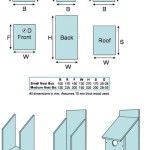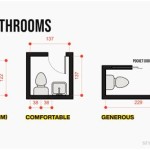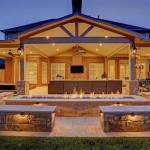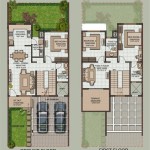Creating a House Floor Plan: A Comprehensive Guide
Designing a house floor plan is a fundamental step in any construction or renovation project. A well-conceived floor plan not only dictates the physical layout of the structure but also significantly impacts functionality, flow, and overall livability. Whether embarking on a new build or remodeling an existing space, understanding the principles and processes involved in creating an effective floor plan is crucial for achieving a successful outcome.
The creation of a house floor plan involves a series of thoughtful decisions and considerations. It is not simply about arranging rooms; it is about crafting a space that meets the specific needs and lifestyle of the occupants while adhering to building codes, optimizing available space, and ensuring structural integrity. This article will delve into the key elements of floor plan design, offering a detailed guide to navigate the planning process effectively.
Determining Needs and Defining Requirements
Before even sketching the initial outline, a thorough assessment of needs and requirements is paramount. This stage involves identifying the number of occupants, their individual preferences, and the specific functions each room will serve. Consideration should be given to both current and future needs, accounting for potential changes in lifestyle and family dynamics.
The number and size of bedrooms and bathrooms are primary considerations. The need for home offices, guest rooms, or specialized spaces such as studios or workshops should also be evaluated. Furthermore, the desired style of living – whether formal or informal – will heavily influence the layout and arrangement of rooms. Open-concept living spaces, for example, are often preferred for casual, social interaction, while more traditional layouts may feature distinct, separate rooms.
Accessibility is another critical factor. If any occupants have mobility issues, the floor plan must incorporate wider doorways, accessible bathrooms, and ramps or elevators where necessary. Building codes often mandate specific accessibility standards, which must be adhered to throughout the design process.
Beyond the functional aspects, aesthetic preferences also play a crucial role. The desired architectural style – such as modern, contemporary, traditional, or rustic – will influence the overall design and the selection of materials. The floor plan should complement the chosen style and create a cohesive and visually appealing environment.
Budget constraints are an unavoidable consideration. The size and complexity of the floor plan will directly impact construction costs. It is essential to establish a realistic budget early on and to prioritize needs accordingly. Simplifying the design or opting for more cost-effective materials can help to stay within budget without compromising essential features.
Developing the Floor Plan Layout
Once the needs and requirements have been clearly defined, the next step is to develop the actual floor plan layout. This involves arranging the rooms in a manner that maximizes functionality, flow, and efficiency. Careful consideration should be given to the placement of each room in relation to others, as well as to the overall orientation of the house on the site.
The placement of the entrance is a critical decision. The entrance should be welcoming and accessible, providing a clear sense of arrival. It should also be strategically located to provide easy access to the main living areas. A foyer or entryway can serve as a transitional space between the exterior and interior, providing a place to remove shoes and coats.
The living room is typically the focal point of the house and should be centrally located. It should be spacious and comfortable, providing ample seating and natural light. The living room should also be easily accessible from other areas of the house, such as the kitchen and dining room.
The kitchen is another essential area of the house. It should be designed for efficiency and functionality, with ample counter space, storage, and appliances. The kitchen should also be well-ventilated to prevent the build-up of odors and moisture. Open-concept kitchens that flow seamlessly into the dining and living areas are increasingly popular, promoting social interaction and creating a more spacious feel.
Bedrooms should be located in a quieter area of the house, away from the main living areas. The master bedroom should be larger and more luxurious, with a private bathroom and walk-in closet. Guest bedrooms should be comfortable and inviting, providing a private space for visitors. Bathrooms should be conveniently located near bedrooms and living areas.
Hallways and corridors should be minimized to maximize usable floor space. They should be wide enough to allow for easy passage and should be well-lit to prevent accidents. Utilizing natural light through skylights or strategically placed windows can enhance the feeling of spaciousness and make hallways more inviting.
Storage is often overlooked in floor plan design, but it is essential for maintaining a clutter-free and organized home. Ample closet space, built-in shelving, and attic or basement storage should be incorporated into the design. The location of storage areas should be carefully considered to ensure easy access and convenience.
The orientation of the house on the site is also a critical factor. The floor plan should be designed to take advantage of natural light and ventilation. Rooms that are frequently used during the day, such as the living room and kitchen, should be oriented to receive ample sunlight. Bedrooms should be oriented to minimize morning sun exposure, promoting better sleep. Natural ventilation can be enhanced by strategically placing windows and doors to create cross-breezes.
Consideration must be given to plumbing and electrical systems. Bathrooms and kitchens should be located near existing plumbing lines to minimize installation costs. Electrical outlets and lighting fixtures should be strategically placed to meet the needs of each room. A detailed electrical plan should be developed in conjunction with the floor plan to ensure adequate power distribution and safety.
Utilizing Tools and Resources
Creating a house floor plan can be accomplished using a variety of tools and resources, ranging from traditional drafting methods to sophisticated software applications. The choice of method depends on the complexity of the project, the designer's skill level, and the available budget.
Traditional drafting methods involve using paper, pencils, rulers, and other drafting tools to create a hand-drawn floor plan. This method is suitable for smaller, simpler projects and allows for a high degree of control and precision. However, it can be time-consuming and requires a strong understanding of architectural drafting principles.
Computer-Aided Design (CAD) software offers a more efficient and versatile approach to floor plan design. CAD programs allow users to create detailed, accurate drawings on a computer. They offer a wide range of features, including automated dimensioning, layering, and 3D modeling. Popular CAD programs for floor plan design include AutoCAD, Revit, and SketchUp.
Online floor plan builders are another option. These web-based tools are typically user-friendly and offer a simplified interface for creating basic floor plans. They often include libraries of pre-designed furniture and fixtures, making it easy to visualize the space. While online floor plan builders may lack the advanced features of CAD software, they can be a good option for homeowners who want to create a simple floor plan without investing in expensive software.
Regardless of the chosen method, it is essential to have accurate measurements of the existing space. Measuring the walls, doors, and windows with precision is crucial for creating an accurate and functional floor plan. Laser measuring tools can be used to obtain precise measurements quickly and easily.
Consulting with an architect or professional designer is highly recommended, especially for complex projects or renovations. Architects have the training and experience to create floor plans that are both functional and aesthetically pleasing. They can also provide valuable insights into building codes, structural considerations, and sustainable design practices.
Building codes and zoning regulations must be adhered to throughout the floor plan design process. These regulations dictate minimum room sizes, setbacks from property lines, and other important requirements. It is essential to research and understand the applicable building codes and zoning regulations before finalizing the floor plan.
The creation of a house floor plan is an iterative process. It may involve multiple revisions and refinements as the design evolves. It is important to be flexible and open to new ideas. Seeking feedback from family members, friends, or professionals can help to identify potential issues and improve the overall design.
Finally, once the floor plan has been finalized, it should be documented in detail. This includes creating a set of architectural drawings that show the dimensions of each room, the location of doors and windows, and the placement of appliances and fixtures. These drawings will serve as the basis for construction and should be carefully reviewed by the contractor before work begins.

Easy Home Building Floor Plan Cad Pro

Floor Plan Creator And Designer Free Easy App

Floor Plan Creator Powerful And Design App Roomsketcher Create Simple Plans Planner

From Sketch To Reality How Design A House You Ll Love

Floor Plan Creator And Designer Free Easy App

20 Best Floor Plan Apps To Create Your Plans Foyr

How Much Do 3d House Plans Cost Faqs Answered Cedreo

Draw Floor Plans With The Roomsketcher App

Small House Plans Popular Designs Layouts

Where You Can Buy House Plans Live Home 3d
Related Posts








